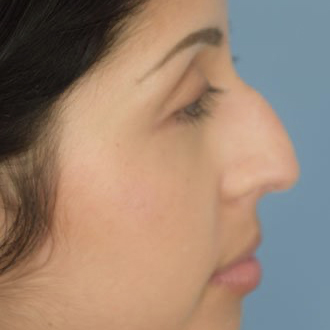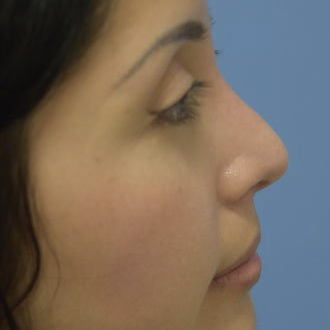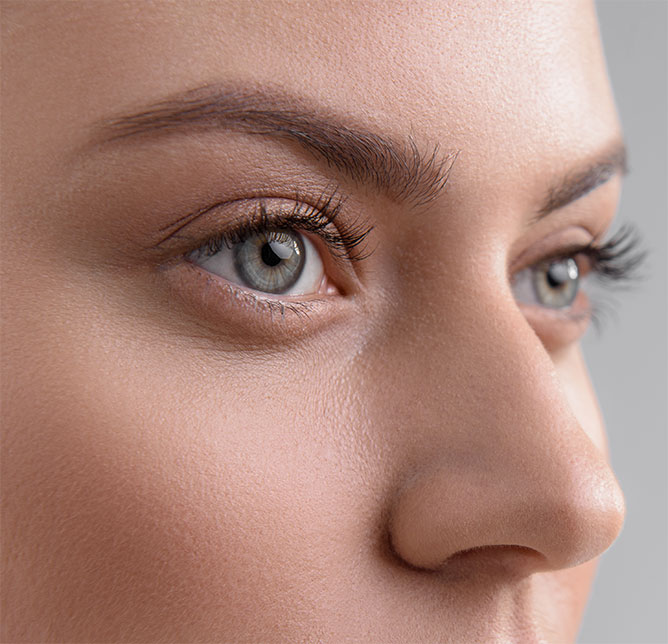See the remarkable transformations and the artistry of Dr. Ambay. Witness how a Rhinoplasty has helped Tampa patients achieve their desired look and newfound confidence.
 Before
Before
 After
After
See the remarkable transformations and the artistry of Dr. Ambay. Witness how a Rhinoplasty has helped Tampa patients achieve their desired look and newfound confidence.
*Results may vary
*Results may vary
Every face is different, and so is every nose. When Dr. Ambay performs rhinoplasty, he considers the harmony of your facial features, ethnicity, and lifestyle to sculpt the result you desire. Rhinoplasty, a popular choice among Tampa residents, can address both cosmetic concerns and breathing issues in a single procedure. As a triple-board-certified plastic and reconstructive surgeon, Dr. Ambay is among Tampa’s leading rhinoplasty specialists, offering digital imaging so patients can visualize outcomes before surgery and ease anxiety. From first visit to final follow-up, you can expect concierge-level care and honest guidance.

Our team at Ambay Plastic Surgery, in Tampa, Florida, uses minimally invasive techniques to reshape your nose by eliminating bumps, crookedness, or size issues. The cause of this can be due to genetics or a previous injury. A skillfully performed Rhinoplasty (nose job) can create a refined nose that is appropriate for your facial features, helping to boost your confidence and self-esteem.
A prominent bridge can distract from other facial features. Dr. Ambay precisely removes excess bone and cartilage to create a smooth profile and seamless transition from forehead to tip.
An overly round or drooping nasal tip can make the nose appear larger. Cartilage reshaping narrows and supports the tip, giving definition without compromising airflow.
A twisted septum often blocks one or both airways. Combining functional septoplasty with Tampa rhinoplasty straightens the septum, relieves congestion, and aligns the nose aesthetically.
Sports injuries or accidents may leave crooked bones and scarred tissue. Revision of these defects restores symmetry and confidence while protecting delicate nasal structures.

Dr. Ambay offers two Tampa rhinoplasty options, primary and revision, customizing each procedure to refine nasal structures, restore facial balance, and resolve functional or aesthetic concerns from previous surgeries.
Your nose directly contributes to the proportions and balance of your face. If you are unhappy with the appearance of your nose, then a rhinoplasty might be right for you. It can improve the way you look and increase your confidence by correcting the size and shape of your nose.
Revision rhinoplasty, also known as secondary rhinoplasty, is a specialized nose job is a surgical procedure performed to correct or improve the results of a previous nose surgery. This type of surgery can be more complex than a primary rhinoplasty due to the changes in anatomy and scar tissue. Patients seek revision rhinoplasty for various reasons, including dissatisfaction with the original outcome or complications from the first surgery. Dr. Ambay is considered by many to be the best nose job surgeon in Florida for these complex cases.
At our Wesley Chapel office, you will be in the skillful hands and care of Tampa’s best rhinoplasty surgeon, Dr. Ambay, who meticulously performs rhinoplasty using one of the following approaches to achieve your desired goal.

Honest, straightforward advice given by a triple board-certified plastic surgeon, widely regarded as the best rhinoplasty surgeon in Tampa.

High standards of surgical precision, artistry and care

A surgeon who listens and acts with empathy and understanding

Experience with advanced surgical techniques and cutting-edge technology

Delivers consistent, beautiful results from rhinoplasty to body contouring and more

A recipient of the President’s Award from the American Society of Plastic Surgeons

The procedure is performed as an outpatient procedure in our state-of-the-art surgery center under light general anesthesia. Depending on the surgical plan and your medical history, there may be options for other types of anesthesia.
During your consultation, Dr. Ambay will take the time to address your concerns, explain the specifics of the correction and create a plan to achieve your desired results. He will help you achieve a natural-looking nose to fit your facial proportion and enhance your overall appearance.
To prepare for rhinoplasty, patients should follow several steps:
Dr. Ambay will provide you with specific instructions tailored to your individual needs to ensure the best possible outcome and a smooth rhinoplasty recovery.
Rhinoplasty with Dr. Ambay in Tampa typically takes between one to three hours, depending on the complexity of the procedure and whether it’s a primary surgery or a revision. Dr. Ambay will provide a personalized time estimate based on your unique surgical plan. During the procedure, he will use either the open or closed technique and carefully re-drape the skin to reflect the refined shape of your nose before closing the incisions. To support healing and maintain the new contour, surgical tape is applied, and a splint may be placed if the nasal bones are reshaped.
The healing process varies, but most patients can return to work and most normal activities within 2 weeks. Complete healing, when the final results of the surgery are apparent, can take up to a year, especially for the resolution of all swelling. Immediately after surgery, breathing through your nose may be difficult due to swelling and the presence of splints or packing inside the nose. This is temporary. Most patients find that once the initial swelling subsides and any internal supports are removed, they can breathe through their nose, often better than before surgery.
You may be a good candidate for a nose job if you are in good health and struggle with the following:
Rhinoplasty is often considered less painful compared to other plastic surgery procedures, offering a relatively comfortable recovery process. Here’s what you can expect during your rhinoplasty recovery period:
Dr. Ambay and his team will provide you with detailed instructions during your pre-operative visit, which is crucial to follow for a smooth recovery. These will cover medication instruction, surgical site care and follow-up appointments.
The journey to full recovery from a rhinoplasty is unique for each patient, with the complete healing process potentially taking up to 6 months to a year. This timeframe allows for the final, subtle refinements to fully manifest.
Patients can look forward to enjoying the following:
Like any surgical procedure, rhinoplasty carries certain risks, but it is generally considered safe when performed by a qualified and experienced plastic surgeon. Potential risks include infection, bleeding, breathing difficulties or dissatisfaction with the aesthetic outcome. Choosing a board-certified plastic surgeon like Dr. Ambay, who has extensive experience in rhinoplasty, can minimize these risks.
To achieve comprehensive facial rejuvenation, Dr. Ambay can discuss combining your Rhinoplasty with other procedures. This approach can optimize your results and overall facial harmony.
Augmenting a recessed chin enhances jawline strength and creates pleasing proportions between chin and nose, boosting overall harmony in as little as one hour.
Eyelid surgery removes excess skin and fat, brightening the eyes. When combined with rhinoplasty, patients achieve a refreshed, youthful appearance with a single recovery period.
Strategic fat grafting softens hollow cheeks or temples. Alongside nose job surgery, it restores volume for a smoother, healthier look.
The cost of a Rhinoplasty varies based on your goals and the treatment plan. There are several financing options available to patients of Dr. Ambay. For a detailed estimate, we recommend scheduling a consultation.
The best age for a nose job is typically after the nose has finished growing and maturing. For most individuals, this occurs around age 16 for girls and a bit later for boys. It’s also important for the patient to be emotionally mature and have realistic expectations about the outcomes of the surgery. There is no upper age limit for rhinoplasty, as long as the patient is in good health.
Swelling after rhinoplasty is normal and varies among patients. Initial swelling decreases within the first few weeks, but subtle swelling, especially on the tip of the nose, can last up to a year. Most patients see the final shape of their nose after this period.
To reduce swelling after rhinoplasty, follow these tips:
You should avoid sleeping on your side for at least 4 to 6 weeks after rhinoplasty to prevent putting pressure on your nose, which can affect the outcome. It’s best to sleep with your head elevated on pillows to reduce swelling and support healing.
Insurance coverage for rhinoplasty depends on the reason for the surgery. If it’s performed for cosmetic reasons, it’s unlikely to be covered. However, if rhinoplasty is necessary for medical reasons, such as correcting a deviated septum to improve breathing, insurance may cover some or all of the costs. We recommend consulting with your insurance provider and our office for a pre-approval.
DISCOVER THE


Your skin changes with age, and sometimes it can lead to lowered self-esteem that challenges your confidence. Dr. Ambay’s facial rejuvenation treatments can help combat this - be it a facelift, rhinoplasty facial implants or a neck lift. He can help restore your joy and rejuvenate you from the outside in.
A woman’s breasts go through many changes such as alterations in the size, shape and firmness. These changes can all be reversed or improved upon with a breast lift, breast reduction or breast augmentation using implants or your own fat. You feel more confident and comfortable in your body.
Dr. Raj Ambay can help you sculpt and shape the body you desire: Be it a tummy tuck, liposuction, mommy makeover, loose skin from weight loss or Brazilian butt lift, his eye for detail can help you achieve your goals for the perfect body that fits You!
Dr. Raj Ambay has the surgical technique, experience, and artistic skill to help contour your ideal body. He offers a full range of body contouring procedures.
Dr. Ambay is a triple board-certified plastic surgeon who specializes in cosmetic procedures for the face, breasts and body. By offering a wide variety of procedures, he can consistently achieve the aesthetic desires of his patients throughout the Tampa and Wesley Chapel area, and beyond.
Dr. Ambay's Google Scholar
Explore our patients' reviews to discover why Dr. Ambay is consistently rated as the top choice for plastic surgery in the area. With years of experience and a dedication to personalized care, Dr. Ambay has earned a reputation for excellence and trustworthiness in Spring Hill, Wesley Chapel, and throughout Florida's surrounding areas.